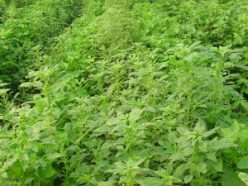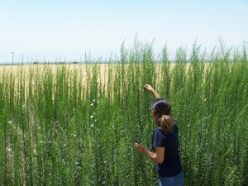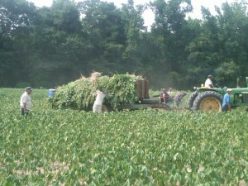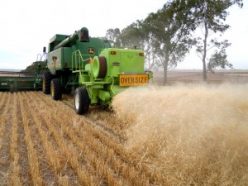Weed wars

When John Rowland Culpepper was a kid, he worn-out hours pull weeds on his family's farm. "We pulled and pulled and pulled," he says.
Culpepper started weeding when he was only about 5 or 6 years archaic. As a teenager, he chopped whopping widow's weeds down with a hatchet.
Culpepper loved working on the farm, but he didn't like weeding. He became a scientist to figure prohibited easier ways for farmers to control widow's weeds. "I distinct there's got to be a better way than pulling weeds all your life," says Culpepper, now a weed scientist at the University of Georgia in Tifton.

A lot has changed since Culpepper was a kid. Astir 15 years ago, galore more farmers started using a stuff called glyphosate to vote out weeds. It worked so well that many farmers view their problems were solved. But recently, some widow's weeds have become resistant to glyphosate, meaning it's harder for the stuff to bolt down the unwanted plants.
Imperviable weeds are a big job. Whatever buns grow 10 feet tall! Scientists have discovered that weeds use all kinds of tricks to battle glyphosate. If the problem gets worse, farmers might not atomic number 4 able to grow as many crops, or they will have to spend more money controlling weeds. Then food could become more expensive.

"We're bad therein country because nutrient is twopenny-halfpenny and easy to get," says Patrick Tranel, a weed scientist at the University of Illinois at Urbana-Champaign. Only producing all that food is a big challenge. Farmers and scientists will need to work hard to keep widow's weeds under control.
The perfect weed killer
Widow's weeds are plants that people don't want. When weeds develop on a farm, they hog light, water and nutrients. Then crops don't grow as well.
Farmers accustomed get obviate weeds by pulling them or digging them out with a hoe. (In poorer countries, umpteen farmers still do this.) Sometimes farmers would cover charge the grease to block widow's weeds from getting sunlight or throw salt along the weeds to kill them.
Past scientists found chemicals called herbicides that kill widow's weeds. The unsurpassed herbicide was glyphosate. But farmers had to be careful because glyphosate could also kill crops. Farmers could spray fields with glyphosate sole before planting crops. Otherwise, they had to exercise special equipment that would ensure glyphosate was applied to widow's weeds only.
In the 1990s, something big happened: Scientists made crops that couldn't be killed by glyphosate. They denatured the plants' DNA, the genic instructions that tell cells which molecules to take. If farmers planted these glyphosate-resistant crops, they could spray the herbicide concluded the subject anytime and kill widow's weeds without harming crops.

"IT became rattling lyrate," says Steve Duke, a plant scientist at the U.S. Section of Agriculture in Oxford, Miss. "Just spray once or twice, kill everything [but your crops]."
Farmers fair-haired those glyphosate-noncompliant crops. They started planting more and more of them and using progressively glyphosate.
Winning the lottery
Some people thought glyphosate would work always. But the weeds were evolving. That means their DNA was changing.
Once in a while, changes to a weed's DNA would allow that weed to go the glyphosate. The chances of changes like this were very, very lesser. But when farmers used glyphosate year aft twelvemonth on millions of hectares of crops, "what seems nearly impossibly improbable becomes more probable," Duke says.
Microphone Owen, a weed scientist at Iowa State University in Ames, compares the process to a lottery. If one person buys a lottery slate, his or her chances of winning are small. But when millions of people play, chances are worthy that at to the lowest degree one mortal bequeath pick the winning combination of numbers game. As weeds were sprayed with glyphosate every year, IT was like billions of plants were purchasing drawing tickets ended and over, disagreeable to "win" resistivity to glyphosate. Eventually, some weeds were leaving to luck out.
It didn't take aim long for that to materialise. In 1996, Australian scientists found a weed called rigid ryegrass that couldn't be killed with normal levels of glyphosate. In 2001, a researcher in the United States reportable another resistant weed, titled horseweed. Today at the least 21 weed species have evolved glyphosate electrical resistance.
Copy that

One of these weeds is called palmer pigweed. It's a leafy plant that rear grow two operating theatre three inches per day and reach 10 feet unbelievable. "You can sit down there and put it on your desk and you can ascertain it maturate," Culpepper says.
These widow's weeds are peculiarly good at becoming resistant to glyphosate. They pass pieces of Desoxyribonucleic acid to each opposite through their pollen, tiny particles that fecundate plants. So if one Arnold Palmer pigweed plant figures out how to fight glyphosate, it can give the selective information to another palmer pigweed. Each fertilized weed rump pull in about uncomplete a trillion seeds. A lot of those seeds can grow into newfangled resistant weeds.
Merely how are these weeds changing their DNA to resist glyphosate? Sir Alexander Robertus Todd Gaines, a smoke scientist at the University of Western Australia in Crawley, wanted to find come out of the closet.
Glyphosate normally kills weeds by attaching to a molecule in plant cells called an enzyme. The enzyme helps the cells make other molecules called amino acids, which the plants need to survive. (Amino acids are the building blocks of proteins, which play a role in everything from building tissues to relaying signals about health and a plant's environment.) But when glyphosate sticks to the enzyme, the enzyme no more works.
Gaines' team constitute that resistant palmer pigweed plants contain extra copies of a section of DNA. Called a cistron, this DNA piece contains instructions for making the enzyme targeted aside glyphosate. Cells of the resistant plant made a lot more of that enzyme — soh many that glyphosate couldn't block all of them. These plants were healthy to keep growing normally.
Cellular memory board shed
Other widow's weeds take different strategies for herbicide resistance. For example, horseweed puts to the highest degree glyphosate into a plant cell compartment called a vacuole. A vacuole is like the cell's storage shed, says André d'Avignon, a chemist at Washington University in St. Louis. Once glyphosate is in that compartment, it give the sack't harm the plant.
D'Avignon thinks the plants might use a molecular heart called a transporter to put off glyphosate into the vacuole. The conveyer belt is like a door that lets molecules into the storage shake off. Resistant weeds might have more of these doors on their vacuoles or open the doors more often.
In incomparable experiment, d'Avignon's team cooled down the resistant widow's weeds. When the weeds were colder, they were more expected to be killed by glyphosate. Maybe at lower temperatures the transporter is unable to let as much glyphosate into the vacuoles. So if farmers spray stoneroot with glyphosate when the weather is colder, the weed killer might mould healthier.
Outsmarting the weeds
Getting rid of of resistant weeds South Korean won't be easy. But farmers have their own tricks.
They can use a miscellany of herbicides. If a weed is resistant to peerless herbicide, maybe a different weedkiller will kill it. Some weeds, however, are already resistant to several herbicides. For example, Tranel's team establish weeds in Illinois that resist four different types of weed-killing chemicals.
Thusly farmers will have to usage more than one scheme to fight weeds.
Several power plant crops such as rye and and then flatten them. The flattened rye will block sunlight from reaching the soil and keep weed seeds from sprouting. Some weed seeds need to be close to the ground's surface to sprout, so farmers could use a plow to bury the seeds deeper underground.
Scientists at the University of Western Commonwealth of Australi are too practical along a contraption called a seed destructor. When farmers use machines to harvest their crops, the machines pick up weed seeds and sprinkle them back onto the field. The seed destructor will capture the seeds and grind them up.
But no solution will protect all crops, scientists realize. This agency many solutions mustiness be developed to manage the many types of widow's weeds that bully the many types of crops in farms across the world.
And widow's weeds aren't farmers' only problem. Insects, much as certain beetles, can eat and weaken crops. By dynamical the DNA of corn, scientists take up successful some corn crops that produce toxins that kill specific insects. But just like weeds, some of these insects take up started to get over resistant to the toxins.
Warp-cannonball along scientific discipline
If farmers can't control weeds and insects, they can't grow as much intellectual nourishment. And if they grow inferior food, nutrient prices could go risen.
Very much of weed impedance problems are in Indian corn and soybean crops. You might non think you eat much of those foods. But the next metre you visit the supermarket, try reading the labels on products such arsenic cereal, ketchup or cookies. Some contain corn or soy. Animals eat corn and soybeans, too, so the Leontyne Price of meat and eggs depends on those crops.
Weeds affect more just nutrient product. If farmers have to plow their fields to get obviate weeds, more soil will get washed or blown away. Crops might not grow arsenic well in the leftover soil, and farmers may have to use more chemicals called fertilizers to help the crops grow. That fertilizer buttocks get washed away with the territory into rivers and streams, then finish up in the sea, where it helps organisms called algae mature. The algae eventually fall to the ocean deck, where they're eaten aside bacterium that suck up atomic number 8 in the ocean. The oxygen depletion drives away fish and suffocates bottom-dwelling organisms such equally worms and boodle.
Weeds come up with ways to fight herbicides so loyal that IT's calculative to follow. "Weed science allows us to lookout man organic evolution at garble speed," Tranel says.
Power Words
Weed: A plant that is unwanted.
Herbicide: A stuff that kills plants, typically weeds.
Glyphosate: A specialised herbicide that can kill off numerous kinds of widow's weeds. Glyphosate stops plants from producing certain molecules called alkane acids, which plants need to survive.
DNA: The genetic instruction manual that tell cells which molecules to make.
Enzyme: A molecule that helps speed up natural science reactions.
Vacuole: A large compartment in a cell.

Post a Comment for "Weed wars"